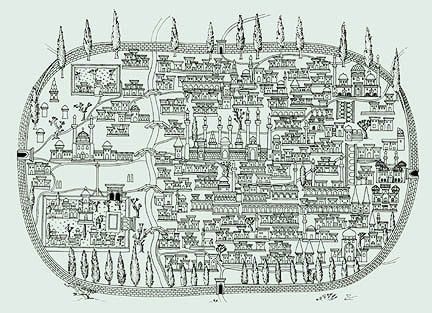|

Winter
1998 (6.4)
Page
11
Editorial
Architecture
and Development
by
Betty Blair
  Among anthropologists
there's an expression, "You are what you eat!" I would
suggest that it's equally true that "You are what you live
in." The aesthetics of the built environment-architecture-affect
our aspirations, our ability to persevere and endure, as well
as our world view, at least subconsciously. Among anthropologists
there's an expression, "You are what you eat!" I would
suggest that it's equally true that "You are what you live
in." The aesthetics of the built environment-architecture-affect
our aspirations, our ability to persevere and endure, as well
as our world view, at least subconsciously.
I've been "commuting" between Los Angeles and Baku
for the past six years since we first began publishing Azerbaijan
International. One thing that never tires me is straining my
neck to look up at the extraordinary ornate buildings in the
center of Baku, especially those dating back to the Oil Baron
period (1885-1920). This last trip was no exception.
Perhaps, the owners of these palatial mansions were mostly thinking
of themselves and didn't fully realize what a tremendous legacy
they were leaving to future generations. Despite the fact that
many of them died in poverty or fled the country after the Bolsheviks
took power in 1920 and confiscated their wealth (See Oil
Barons,
page 29), the influence emanating from what they created cannot
be measured. The residential monuments they left have become
part of the identity of the people who have lived in this city,
especially during this turbulent and isolated century.
 Sketch
of Tabriz (16th century). From an original miniature by N. Matrakchi.
Redrawn by D. Giyasi.
Sketch
of Tabriz (16th century). From an original miniature by N. Matrakchi.
Redrawn by D. Giyasi.
First of all, these buildings pay tribute to the entrepreneurial
spirit of hard work, ingenious strategy and sheer determination
of those who created this wealth. The biographies of the majority
of these owners, mostly Oil Barons, describe individuals who
were born into stark poverty, had very little or no education,
but who became millionaires, seemingly overnight. During the
long winter of the Soviet period (1920-1991), these buildings
stood like strong light beacons reminding passersby of the power
of entrepreneurship and contradicting state policies that discouraged
people from taking their own initiative.
The Oil Barons also set the precedent for investing in the country's
own development in construction and in fostering the development
of educational and cultural institutions. A century later, this
tradition persists in contrast to what seems to be happening
in other oil-developing countries nearby.
These buildings also represent a vibrant example of the strength
and ingenuity that can be created through international cooperation.
Foreign architects, especially those of Polish and German descent,
were invited to work beside local talent to create a unique synthesis
of European and Eastern styles which can be found no other place
in the world. Such a heritage needs to be protected now especially
during the early stages of Azerbaijan's independence and transition
to the market economy, according to architect Pirouz Khanlou
in his article, "The Metamorphosis of Architecture
and Urban Development in Azerbaijan" (page 24).
The eclecticism of the period should be mentioned as well. No
two buildings are alike. It's as if there had been an unwritten
rule that a good thing should never be repeated, though elements
could be incorporated and shaped in new ways. This uniqueness
stands at odds with the Soviet-era ideals of mass-production
and conformity. You see this openness to diversity in relationships
as well. Azerbaijanis are not xenophobic. They embrace diversity
and pride themselves in having friends among many nationalities,
even those whom they feel have wronged them.
Finally, a part of the distinct legacy of the Oil Baron period
is the reminder that all great things can eventually come to
an end. Lack of diversification in a country's economic policy
is dangerous and can lead to collapse. As Natig Aliyev, President of Azerbaijan's
National Oil Company, points out (page 75), Azerbaijanis cannot
sit passively waiting for oil to solve all their problems. Other
aspects of the economy must be developed including industry,
agriculture and non-oil natural resources.
Now is the time for Azerbaijan to make long-term national strategic
plans for development and to build up its infrastructure in health,
education, transportation and communication. In the past, Azerbaijan
had substantially developed its manufacturing sector by producing
metals, steel, aluminum and oil equipment machinery as well as
consumer goods. These days Azerbaijan needs to stimulate the
entrepreneurial spirit in many other facets of its economic life
just like Turkey which has managed to build a healthy economy
despite not having their own natural oil resources. Unless Azerbaijan
does, this period of oil bonanza will leave future generations
in poverty. The classic example of such a failure is Nigeria.
For readers who have never visited Baku, we hope these pages
will intrigue and tempt you to do so. If some day, you find yourself
walking down the streets in the center of Baku, take one word
of advice: keep looking up. It's worth a little neck strain to
discover so many rare architectural marvels in such close proximity
to each other. You'll catch a glimpse of an era of the past that
profoundly influences the hopes and dreams of the community which
lives here today.
From Azerbaijan
International
(6.4) Winter 1998.
© Azerbaijan International 1998. All rights reserved.
Back to Index
AI 6.4 (Winter 1998)
AI Home
| Magazine
Choice | Topics
| Store
| Contact
us
|

